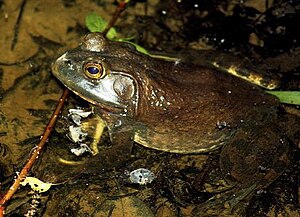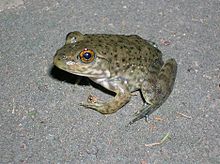North American bullfrog
| North American bullfrog | ||||||||||||
|---|---|---|---|---|---|---|---|---|---|---|---|---|

North American bullfrog ( Rana catesbeiana ) |
||||||||||||
| Systematics | ||||||||||||
|
||||||||||||
| Scientific name | ||||||||||||
| Rana catesbeiana | ||||||||||||
| Shaw , 1802 |
The North American bullfrog ( Rana catesbeiana , syn .: Lithobates catesbeianus ), also called the American bullfrog , is an originally North American amphibian species from the family of real frogs .
features
The North American bullfrog is a particularly large, powerful frog that can reach a head-trunk length of up to 20 centimeters. Also striking compared to other real frogs is their large eardrum , which in males is twice the eye diameter. Small warts are scattered on the back. The back color varies between olive green, gray and brownish, often with irregular dark spots; the head is often light green. In contrast to European water frogs (compare sea frog , small water frog , pond frog ), the bull frog lacks dorsal ridges and a central dorsal stripe, and the males lack paired, lateral sound sacs . The ventral side is whitish with washed-out gray spots or marbling, the throat cream-colored, in males yellowish. The males have dark pigmented oestrus calluses during the mating season . Your unpaired vocal sac is throaty. The deep, grunting single sounds ("brr-oam") thus generated serve as courtship calls and can be heard from afar.
Reproduction

The bullfrog spawning time correlates with water temperatures of at least 17 to 21 ° C; in the southern United States this is mostly the case from February to October. The courting males show a territorial behavior towards competitors. The clasping ( amplexus ) of mated animals takes place axillary as with all "modern" frogs ( Neobatrachia ). The females produce large balls of spawn from 10,000 to 25,000 dark eggs, which float on the surface of the water as "flat cakes". The development of the tadpoles takes an extremely long time on the northern edge of their range of up to three years. In southern, warm regions, however, they only need a few months to go ashore. Older larvae are about 11 to 14 centimeters tall, metamorphosed young frogs 2.5 to 6 centimeters.
Habitat, way of life and distribution
This type of bullfrog inhabits river banks, lakes, larger ponds and ponds, but also rice fields. Dense bank and underwater vegetation is preferred. Bullfrogs are mostly nocturnal. Their food spectrum includes other amphibians, various insects, nudibranchs and snails, snails and occasionally chicks from various water birds, as well as small mammals and young water snakes.
The bullfrog originally comes from eastern and central North America (United States, Canada , Mexico ). He was artificially settled in the western United States. The species was introduced as a neozoon in many other areas as well , such as Cuba , Puerto Rico , Jamaica , Hispaniola ( Haiti , Dominican Republic ), Hawaii , Japan , China and Taiwan . The big frog was also brought to Europe, including Great Britain , Germany (see below), the Netherlands , Belgium , France , Greece and Italy . In Italy in particular, the bullfrog has been able to establish itself permanently and over a large area since the 1930s, especially in the Po Valley and around Rome . In 2018 the bullfrog also appeared in the delta of the Spanish river Ebro and has been fought there ever since. Four adult frogs were caught that have also produced tadpoles.
Threat as a neozoon
Due to their sheer size and the fact that bullfrogs eat anything they can overwhelm, they pose a serious threat as a neozoon as a predator and food competitor. This is especially true for other amphibian species that share their habitats with them. The spread in Europe is promoted by the fact that tadpoles are sometimes offered in the animal trade, which are intended for garden ponds, but where they do not stay as frogs. In Germany, notable populations have built up particularly in the old Rhine floodplains of the Upper Rhine Plain . Unusually large tadpoles do not necessarily have to come from the bullfrog, however: the garlic toad , the midwife toad and the various water frog species also produce very large larvae. Adult animals could be confused with older specimens of the sea frog , which may lack a back line. Another threat to native amphibian species can be the introduction of the chytrid fungus ( Batrachochytridium dendrobatidis ), which is believed to be responsible for the worldwide extinction of amphibians.
The North American Bullfrog has been added to the “List of Unwanted Species” for the European Union.
swell
Individual evidence
- ↑ Amphibiaweb.org (accessed December 31, 2007)
- ↑ Isabel Rubio: La rana toro, una de las especies invasoras más agresivas, se reproduce por primera vez en España . In: El País . August 3, 2018, ISSN 1134-6582 ( elpais.com [accessed August 9, 2018]).
- ↑ List of Invasive Alien Species of Union Concern (PDF) accessed on July 15, 2016
literature
- Matthew C. Fisher, Trenton WJ Garner: The relationship between the introduction of Batrachochytrium dendrobatidis, the international trade in amphibians and introduced amphibian species. In: Fungal Biology Reviews. Vol. 21, No. 1, 2007, ISSN 1749-4613 , pp. 2–9, doi : 10.1016 / j.fbr.2007.02.002 .
- Hubert Laufer: On the prey range of a population of bullfrogs north of Karlsruhe. In: Faunistic Treatises. 25, 2004, ISSN 0375-2135 , pp. 139-150, ( digitized version ).
- Arnold Linke: Europe's first bullfrog farm in the Lüneburg Heath. In: home calendar. Yearbook for the Lüneburg Heath. 2005, ISSN 0945-4942 , pp. 128-130.
- Andreas Nöllert, Christel Nöllert: The amphibians of Europe. Determination, endangerment, protection. Franckh-Kosmos, Stuttgart 1992, ISBN 3-440-06340-2 .
Web links
- Short video with a calling bullfrog at www.invasivespeciesinfo.gov (if a pop-up window appears with "no thanks" click away!)
- Photos of the North American bullfrog at www.herp.it
- Description of the negative effects of the artificial settlement of the bullfrog
- A text that critically deals with sensational press reports about the "bullfrog eating machine"
- Lithobates catesbeianus in the endangered Red List species the IUCN 2006. Posted by: G. Santos-Barrera et al, 2004. Retrieved on 12 May 2006..


